|
| |
Back to
Helicopters
|
|
The Bell UH-1 Iroquois (informally known as
the Huey after its original designation of HU-1) is one of the best
known helicopters in the world. It first flew in October 1956 to
meet a US Army specification for a medium transport helicopter. It
was hugely successful, with over 16,000 eventually being built. It
could officially carry 2 crew plus 7 troops, but in wartime it very
often carried far more. Its official maximum weight of 4,700 Kg was
more than half payload (including fuel). It could travel at 200Km/h for up to
500 Km under the power of its single
1,810Kw Lycoming turboshaft engine. Later models had two lower
powered engines. The top one was at Cranfield in the early 1990s.
and is an early single engined version (Bell 205). The lower one,
operated by the Italian Customs, is an Agusta - built example
(AB412), with two engines and a four bladed rotor, at Fairford in
July 2005. |
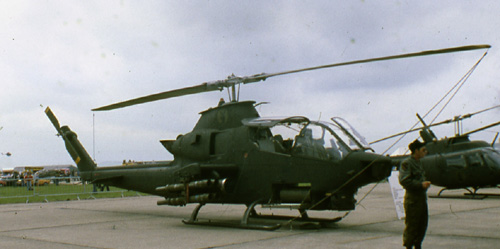 |
The Bell AH-1 Hueycobra was the world's first
dedicated attack helicopter. As its designation implies, it was
created by marrying the dynamic system of the UH-1 to a new,
dedicated fuselage. In addition to two guns, it has four hardpoints
which can carry a variety of weapons. Gross weight is 4,500 Kg,
similar to the UH-1, but the payload is a lower 1,600Kg, the
difference mainly being the weight of the armour plating. The
slender fuselage gives lower drag and therefore higher speed, up to
280 Km/h, over a slightly longer range to the UH-1 (570 Km). It first flew in September 1965, since
when over 2,000 have been built.
|
 |
The Bell XV-15 could be considered either a
helicopter or an aeroplane, depending on which way its engines are
facing! Only two were built, for use as the aerodynamic test
vehicles for the V-22 Osprey, now entering service with the US armed
forces. The tilt-rotor concept allows the aircraft to take off and
land like a helicopter, but in flight the engines tilt to enable it
to cruise like a normal aircraft. Thus it aims to get the best of
both worlds, at the cost of considerable weight and complexity. It
first flew in 1977, and can achieve a top speed of 615Km/h. Range is
a respectable 825 Km. Maximum weight is 5,900 Kg. It has two
Lycoming LTC1K engines, each of 1,150 Kw.
This one was at Paris - Le Bourget in June
1981. |
 |
The Sikorsky HH-3 (company designation S-61R)
is a variant on the ubiquitous Sea King design. It is mainly a
transport machine, carrying up to 26 passengers plus crew. Its two
1,040 Kw GE T58 turboshaft engines give it a top speed of 265 Km/h
and a range of 1,000 Km, with a maximum weight of 9,750 Kg, of which
4,370Kg is payload. The hull is optimised for landing on water,
enabling it to survive ditchings and also making it highly suitable
for naval operations, including air-sea rescue. Many versions are
used in the anti submarine role. Since its first flight in March
1959, 870 have been built (not including the Westland Sea Kings); of
those, 115 are civil and the rest military, 265 being the `R'
variant illustrated here.
This one (an HH-3F built under license by
Agusta in Italy) was at Fairford in July 2007. |

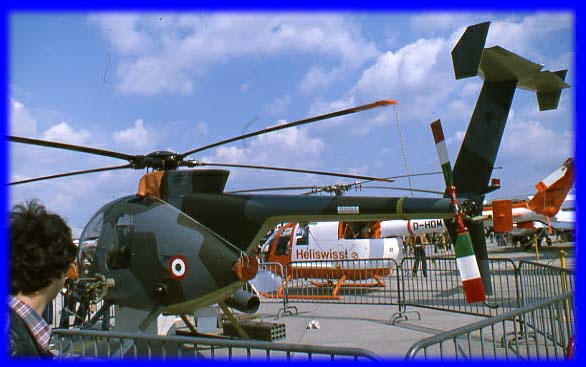 |
The Hughes OH-6 won the US
Army's competition for a light observation helicopter in 1963, beating the Bell JetRanger and
Fairchild-Hiller FH1100. Seating five, it is powered by a single
263Kw Allison T63 turboshaft. Its four blade rotor is quite short,
rotating at high speed, and therefore much quieter than the
competing two bladed types. It first flew in February 1963. It is
quite quick, with a top speed of 274 Km/H, and it has a reasonable
range of 610Km. The airframe itself is very light, giving a payload
(including fuel) of 700 Kg out of a total gross weight of 1,225Kg.
Across all models, it has been phenomenally successful, with almost
5,000 built. There have also been civil versions, known as the
Hughes 369 or Hughes 500, illustrated on the civil page.
The top picture shows an OH6 in Danish colours at
Middle Wallop in July 1986. The lower one is an updated Hughes 500M,
in Italian colours, being demonstrated at Paris - Le Bourget, in the 1980s. |
 |
The Vertol CH-46 Sea Knight (also known by
its company designation of Vertol 107) is a development of the
tandem rotor concept invented by pioneering helicopter designer
Frank Piasecki. The rotors are coupled and geared so that they
intermesh but do not collide. Having two rotors gives extra lift and
stability, and dispenses with the need for a tail stabiliser, but at
the cost of considerable complexity, especially the safety
considerations required to prevent a failure of the drive to one of
the two rotors, which would of course destabilise the aircraft. The
CH-46 is a heavy lifter, with gross weight of 11,000 Kg, payload of
2,700 Kg and capacity for 25 troops. Top speed is 253 Km/h but range
is only 370 Km. It first flew in April 1958. 520 were built, mostly
for the US forces. It is powered by two General Electric T58
turboshafts, each of 1,770 shaft horsepower (1,282 Kw).
This one, used as an air sea rescue helicopter by
the Canadian forces, was at Comox in September 1981. |
 |
The Boeing-Vertol CH-47 Chinook was a larger
and more powerful derivative of the CH-46, and was mainly produced
following Boeing's purchase of the Vertol company in the early
1960s. Its two Lycoming T55 turboshafts each give 2,760 Kw. The huge
slab-like rotors overlap, giving a very loud clacking sound when it
is flying. I remember one flying low and fast over a conference
centre where I was and setting all the car alarms off! It can lift
10,500 Kg (it can pick up an unladen CH-46 easily); maximum gross
weight is 17, 450 Kg. It is faster than the CH-46, at 300 Km/h, and
has a much longer range, 2,140 Km. It first flew in September 1961.
About 750 have been made to date. Many of the oldest have been
remanufactured to modern CH-47D standards. New ones are still
available.
(CH-47D of Royal Netherlands Air Force -
Koninklijke Luchtmacht, Fairford, July 2005). |
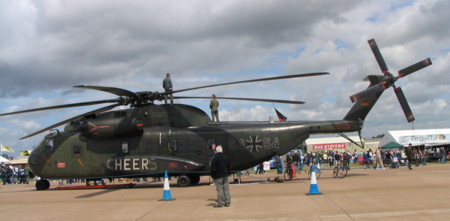 |
if you thought the Chinook was big, the Sikorsky CH-53
makes you think again! With a gross weight of 33,300 Kg and payload
of 18,000 Kg, the CH-53 can happily take 55 fully equipped troops,
or a variety of payload ... or lift a Chinook! It is conventional
design, with a tail rotor stabiliser, but is fast: top speed is 315
Km/h. It has a very useful range of 2,075 Km. It is powered by three
General Electric T64 turboshafts, each giving 3,925 shp (2,840 Kw).
It first flew in October 1964, and is still in production (Summer
2005). 350 have been built. They are very well suited to long range,
high speed, low level insurgency missions, and as such are well
loved by the Marines! This CH-53G was at
Fairford in July 2007. Note the graffiti: `HEER' (for Heeresflieger,
the German Army Aviation, having been altered to CHEERS! |
 |
The Bell OH-58D Kiowa is superficially just a
military JetRanger (see civil helicopters). But underneath lie big
differences. The four blade rotor (as on the 406) is specially
damage resistant. The Longbow fire control radar above the rotor is
very apparent. Note also the cable cutters above the cockpit and
below the nose, the reshaping of the rear engine compartment (for
reduction of infra-red signature) and evidence of the advanced
avionics fit. Its 650hp Allison 250 turbine engine gives it a top
speed of 147mph and range of 345miles. First flown in 1985, it is
still in production in the 21st century.
Farnborough, September 1986 |
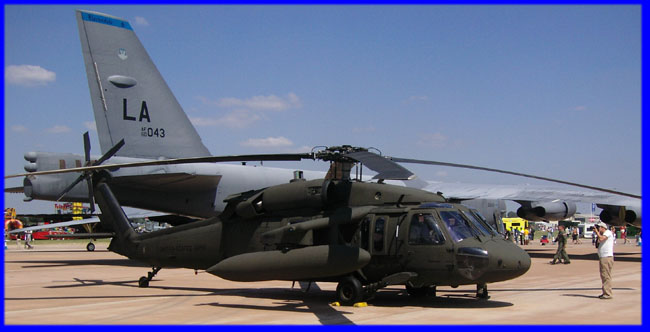 |
The Sikorsky UH-60 Black Hawk is the US
Army's replacement for the venerable UH-1. It is a bigger
helicopter, with a normal crew of 3 and capacity for up to 20 troops
plus various light armament. It is heavier too, gross weight being
9,200 Kg and payload 4,350 Kg. It is also faster - 296 Km/H - and
has slightly longer range, 600 Km. It is powered by two General
Electric T700 engines of 1,560 shp (1,130 Kw) each. Since its first
flight in October 1974, about 2,000 have been made, in many
different versions for many different air forces.
This one was at Fairford, July 2005 |
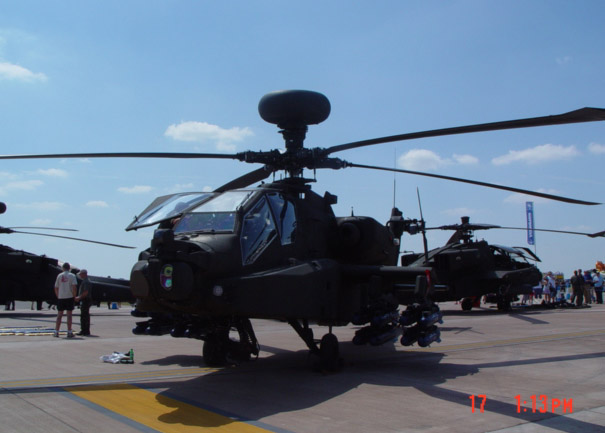
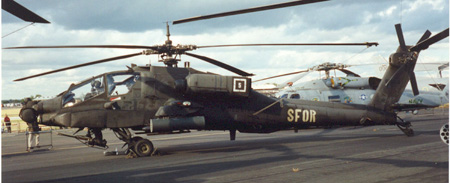 |
The Hughes (now McDonnell Douglas
Helicopters) AH-64 Apache is a heavily armoured attack helicopter
designed to replace the AH-1. It can carry a wide range of possible
armament, especially rockets, on the hardpoints under its stub
wings. its strong armour makes it very heavy, with a gross weight of
10,100 Kg and payload of 4,750 Kg. Top speed is 260 Km/h. Range is
not brilliant, only 410 Km - but this is generally enough! it is
powered by two 1,940shp (1,450 Kw) General Electric T700 turboshafts.
Since its first flight in September 1975, over 1,000 have been
built, mostly for the US forces.
Most recent examples (such as the one in the
top picture, seen
at Fairford in July 2005) are equipped with the Longbow fire control
radar, mounted in the pod above the main rotor. This enables it to
lurk below the tree tops and still see and shoot its enemy. Other
instruments include night vision, thermal imaging and laser target
designation. At one point in the recent Iraq war, an entire Iraqi
division is rumoured to have surrendered when just two of these
formidable machines appeared! The lower picture shows an AH64 at
Farnborough in September 1998. |
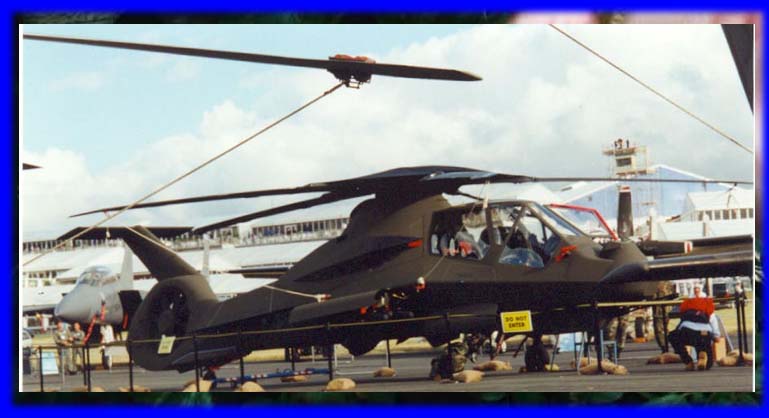 |
The RAH-66 Comanche was a joint venture
between Boeing and Sikorsky to produce a very fast, stealthy,
armoured light attack helicopter. It was armed with a single gun,
but could also carry a variety of other weapons if it compromised
its stealth characteristics. Gross weight was 7,870 Kg and payload
(including armament, two crew and fuel) was 4,300 Kg. Top speed was
328 Km/H and range a massive 2,330 Km. It was powered by two LHTEC
T800 turboshafts of 895 Kw each. This one was at Farnborough in
September 1998. `Was'? Is that the right
word to use for such a modern, capable machine? Sadly, yes -
development costs were gigantic, the stealth requirements were
making production costs even worse, so the programme was cancelled
after only two had flown. |





|